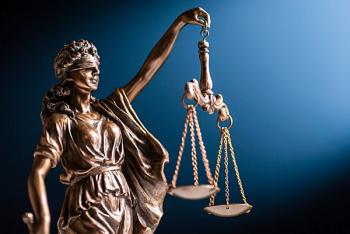
Overview of small animal respiratory endoscopy (Proceedings)
As the veterinary profession grows and becomes more specialized, many veterinarians are learning procedures such as bronchoscopy and integrating this specialized procedure into their clinics.
As the veterinary profession grows and becomes more specialized, many veterinarians are learning procedures such as bronchoscopy and integrating this specialized procedure into their clinics. We will be examining what it takes to perform a bronchoscopy as well as a rhinoscopy, a more familiar procedure in the veterinary practice.
The Small Animal respiratory system is comprised of the Upper & Lower Respiratory systems. The upper system includes rhinoscopy and nasopharyngoscopy, and the lower system includes laryngoscopy and bronchoscopy.
Rhinoscopy is the visual examination of the nasal cavity. It is mainly utilized as a part of a complete diagnostic nasal disease workup. Indications include sudden onset sneezing, reverse sneezing, discharge, epistaxis, facial swelling, and loss of nasal airway patency. Retroflex behind the soft palate, or Nasopharyngoscopy, is a part of every upper airway workup at the VMTH.
Instrumentation for rhinoscopy includes both rigid and flexible endoscopes. The smaller pediatric fiberoptic endoscopes like the Olympus P-20d, (outer diameter of 5.0 mm. and a 2.0mm biopsy channel), are ideal for retroflexion. Rigid scopes are 2.7 mm outer diameter, have a 0 or 30 deg. field of view, and include a sheath for flush and biopsy capabilities. A c-clamp attachment that comes with most camera systems can be used on rigid scopes along with a light guide cable for visualization.
Biopsy forceps in the nasal cavity include Jackson Debarkers, which have a sharp round cup for biopsying nasal turbinates. They include 2, 3, and 4 mm sizes. They can be placed alongside most rigid scopes and obtain diagnostic visual biopsies. Flexible biopsy forceps of an appropriate size can be used through the sheath of the rhinoscope.
A complete rhinoscopic tableside setup includes labeled cassettes for biopsies, formalin jars, lubricating jelly, saline flush, gauze squares, exam gloves, mouth gags, lap pads, suction, culturettes, cotton-tipped applicators, ice, spay hook and mirror for oral exam, and lidocaine jelly. Oxymetazoline(Afrin), a vasoconstrictor, and Proparacaine nose drops, a topical anesthetic, may also be helpful when used in the nasal cavity.
General Anesthesia is recommended when performing rhinoscopy, a highly stimulating procedure. Anesthesia serves to suppress the sneeze and gag reflexes, and helps keep equipment from being damaged. Make sure the cuff on the endotracheal tube is in working order to keep fluids from reaching the lungs. Rhinoscopy is performed in sternal recumbency with a rolled-up towel or sandbag under the ventral neck. A complete oral exam should be performed first. Tonsils should be probed and examined for foreign material, the hard and soft palate should be palpated, and the tongue should be examined for masses and ulcers.
When performing a nasopharyngoscopy equipment safety is key. Placing lidocaine gel around the soft palate can help with the gag reflex. The endoscope tip is placed just past the soft palate, then flipped up and slightly pulled forward to examine the nasopharynx and choanae, which are the openings from the nasal cavity to the nasopharynx and separated by the vomer bone. Be aware that the image shown is inversed. The nasopharynx is a prime area for biopsy if a mass is seen arising from the nasal cavity. When obtaining a biopsy in this area, place the biopsy forceps in the channel before retroflexing, get the biopsy, then pull the endoscope and the biopsy forceps out of the oral cavity as one unit. This maneuver will safeguard the biopsy channel. When nasopharyngoscopy is complete, the throat is packed with a lap pad to prevent aspiration.
Before beginning rostral rhinoscopy, measure your rigid scope to the level of the medial canthus of the eye and mark with a small piece of tape. This action will remind the endoscopist not to advance the endoscope too far and possibly penetrate the cribriform plate. When performing rhinoscopy, always examine the less affected side first. The normal nasal cavity is pink, smooth and shiny with nasal turbinates packed close together. The cavity is also highly vascular, especially with scope contact. Cold saline flushed into the cavity can help return visualization. Abnormal findings to record include hyperemia, excessive mucus accumulation, mass lesions, turbinate destruction, foreign bodies, and fungal plaques. Biopsies should be performed with visualization to obtain the most accurate diagnosis. Foreign bodies should be removed when first noticed. Alligator forceps work well for removal of grass awns and most plant material.
The most common types of tumors found in the nasal cavity are sarcomas and carcinomas. Older dogs are more predisposed to nasal tumors than older cats. These types of tumors are locally invasive, but usually do not metastasize.
The most common species of fungus encountered in the nasal cavity is aspergillis. Destruction of turbinates and white, fluffy plaques are most commonly seen with this disease. The frontal sinuses can also be affected—often with mycotic rhinitis the flexible endoscope can penetrate the sinus from the nasal cavity and visualization with subsequent plaque removal can be performed. The cribriform plate, a thin plate of the ethmoid bone behind the nasal cavity, can also be damaged from fungal disease— before therapeutic infusion treatment can begin, a CT or skyline view radiograph should be done to assess if the plate has been damaged.
The diagnosis of rhinitis is most always made via histopathology in conjunction with CT and other diagnostic tests. Nasal rhinitis can be classified viral, allergic, or bacterial secondary to other disease processes. Symptoms may include increased mucopurulent discharge. Rhinoscopy reveals thickened, edematous and misshapened turbinates with the increased mucous production. Copious saline flushes with a red rubber catheter or through the sheath of the rhinoscope can be both therapeutic and afford the endoscopist better visualization for diagnostic biopsies.
Foreign body removal, especially plant awns, or foxtails, and blades of grass are a common procedure at the VMTH, especially during the summer. Sudden, episodic and violent sneezing is the chief complaint. Removing the foreign body ASAP gives the endoscopist an advantage—less purulent discharge inside the nasal cavity makes the foreign body easier to see and extract. If a foreign body is suspected and not seen, retroflushing using a large foley catheter placed in the proximal nasopharynx and packed with a lap pad may flush the foreign body out through the nasal passages.
When the rhinoscopy and biopsies have been completed, the teeth may be probed for oronasal fistulae. If the nasal passages are bleeding excessively, an ice pack placed on top of the nose may help. Suction may be needed around the endotracheal tube when the lap pad is removed to prevent aspiration. In some instances leaving the endotracheal tube partially inflated when removing will prevent fluid from entering the lungs.
Laryngoscopy is the examination of the larynx with regard to laryngeal function. It is best performed at anesthetic induction prior to the endotracheal tube being placed. Indications for performing laryngoscopy include respiratory distress, exercise intolerance, voice change and increased respiratory effort. Anesthesia induction agents are slowly administered until the mouth can be opened and the arytenoids observed. If breaths are too shallow or intermittent Doxapram administered at 1mg/kg IV acts as a respiratory stimulant so that laryngeal function can be properly assessed.
Bronchoscopy is a systematic endoscopic examination of the bronchial tree so that abnormalities can be located and identified. This is a "team" procedure and should be seen as an invasive, critical exam and be performed as efficiently as possible to limit anesthesia time. Indications include acute and chronic cough, abnormal breathing pattern, tracheal collapse, neoplasia, and airway obstruction.
Instrumentation—the ideal bronchoscope should be about 5 mm outer diameter and be long enough to accommodate large dogs. Our bronchoscopes are the Pentax FG-16V, which has a 5.5 outer diameter and is 90 cm long, and the Olympus P-20D, which is 5.0mm outer diameter and is 55 cm. long. These endoscopes have a biopsy channel for bronchoalveolar lavage, foreign body retrieval, cytology brushings and biopsy forceps. Foreign bodies should be removed when first seen with biopsy forceps, and biopsies and BALs performed before biopsies and brushings to avoid contamination.
General Anesthesia is necessary to suppress the gag reflex, coughing, and to protect the endoscope. Preoxygenation with a mask is necessary for all patients. Custom short endotracheal tubes can be used for dogs that can accommodate a 7.5 fr tubes or larger, with adapters for gas and scavenge. Jet ventilation or adapting the biopsy channel to administer oxygen will work for smaller patients.
Patients should be in sternal recumbency with a rolled towel under the chin and 2 mouth gags in place. The lubed insertion tip is carefully placed through the arytenoids and into the trachea. Submucosal vessels and a rounded appearance is normal for the trachea. Any collapse of the trachea should be recorded. Next, the carina divides the right and left bronchial tree. Each bronchus should be examined and observed for color change, proliferation of mucus, collapse, dilation, neoplasia and foreign bodies. Sites should also be chosen for possible BALs, or bronchoalveolar lavage.
BAL is saline instilled into an alveolar space and retrieved for culture and cytology. The endoscope is wedged into the most distal bronchus, and the saline is instilled down the biopsy channel. Follow with 3-4 mls. of air to clear the channel. Use short pulls with your syringe to retrieve your sample as the endoscopist moves the tip of the scope up and down and slightly back and forth. A diagnostic sample has a foamy top, or surfactant, which means that the sample has had contact with the alveoli. A retrieval of about 60% of your instilled amount is normal. Multiple samples may be combined for culture.
When the procedure is complete, have suction and an anesthesia mask on hand for compromised patients. The endoscopist records all data and submits all samples from the procedure as soon as possible. The endoscope should be cleaned and processed as soon as the patient is stable.
Newsletter
From exam room tips to practice management insights, get trusted veterinary news delivered straight to your inbox—subscribe to dvm360.




